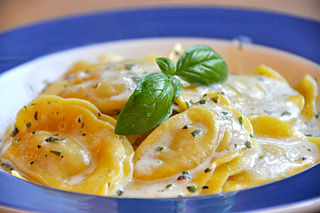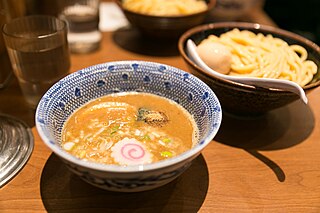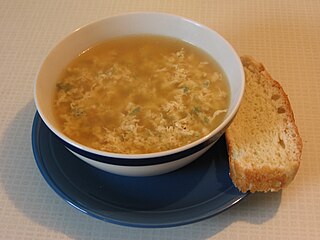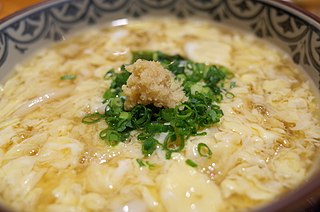Jusselle was an ancient [1] broth-based soup dish prepared using grated bread, eggs, sage and saffron. [2] [3] [4] The ingredients were all boiled together in the broth. [2]
The dish is believed to have originated from the dish juscellum in ancient Roman cuisine, which was included in Apicius , [2] a Roman recipe book that is believed to have been written in the late 4th or early 5th century. In Latin, juscellum or juscullum is "a diminutive from jus , broth or pottage", [5] and is also a late Latin diminutive word for 'soup'. [6] The Sicilian name for the dish sciusceddu is based upon the word juscellum. [lower-alpha 1]
Swithun was an Anglo-Saxon bishop of Winchester and subsequently patron saint of Winchester Cathedral. His historical importance as bishop is overshadowed by his reputation for posthumous miracle-working. According to tradition, if it rains on Saint Swithun's bridge (Winchester) on his feast day it will continue for forty days.

Ravioli are a type of stuffed pasta comprising a filling enveloped in thin pasta dough. Usually served in broth or with a sauce, they originated as a traditional food in Italian cuisine. Ravioli are commonly square, though other forms are also used, including circular and semi-circular (mezzelune).

Avgolemono is a family of sauces and soups made with egg yolk and lemon juice mixed with broth, heated until they thicken.

Russian cuisine is a collection of the different dishes and cooking traditions of the Russian people as well as a list of culinary products popular in Russia, with most names being known since pre-Soviet times, coming from all kinds of social circles.

Hokkien mee, literally "Fujian noodles", is a series of related Southeast Asian dishes that have their origins in the cuisine of China's Fujian (Hokkien) province.

Pennsylvania Dutch cuisine is the typical and traditional fare of the Pennsylvania Dutch. According to one writer, "If you had to make a short list of regions in the United States where regional food is actually consumed on a daily basis, the land of the Pennsylvania Dutch—in and around Lancaster County, Pennsylvania—would be at or near the top of that list," mainly because the area is a cultural enclave of Pennsylvania Dutch culture.

Tripe soup or tripe stew is a soup or stew made with tripe. It is widely considered to be a hangover remedy.

Pancit, also spelled pansít, is a general term referring to various traditional noodle dishes in Filipino cuisine. There are numerous types of pancit, often named based on the noodles used, method of cooking, place of origin, equal and constant diameter or the ingredients. Most pancit dishes are characteristically served with calamansi, which adds a citrusy flavor profile.

Noodle soup refers to a variety of soups with noodles and other ingredients served in a light broth. Noodle soup is a common dish across East Asia, Southeast Asia and the Himalayan states of South Asia. Various types of noodles are used, such as rice noodles, wheat noodles and egg noodles.

Soup is a primarily liquid food, generally served warm or hot, that is made by combining ingredients of meat or vegetables with stock, milk, or water. Hot soups are additionally characterized by boiling solid ingredients in liquids in a pot until the flavors are extracted, forming a broth. Soups are similar to stews, and in some cases there may not be a clear distinction between the two; however, soups generally have more liquid (broth) than stews.

Prawn soup, also referred to as shrimp soup, is a soup dish prepared using freshwater or saltwater prawns as a primary ingredient. Several varieties of the dish exist in various areas of the world, including Penang prawn mee in Malaysia, Peruvian chupe de camarones, Thai kaeng som kung and Mexican caldo de camarones. Prawn and shrimp soup can be prepared as a broth- or stock-based soup, as a cream-based soup, or as a chowder. In the United States, cream of shrimp soup is mass-produced and distributed canned or frozen.

Bread soup is a simple soup that mainly consists of stale bread. Variations exist in many countries, and it is often eaten during Lent. Both brown and white bread may be used.

Tsukemen is a ramen dish in Japanese cuisine consisting of noodles that are eaten after being dipped in a separate bowl of soup or broth. The dish was invented in 1961 by Kazuo Yamagishi, a restaurateur in Tokyo, Japan. Since then, the dish has become popular throughout Japan, as well as overseas in the United States.

Stracciatella, also known as stracciatella alla romana, is an Italian soup consisting of meat broth and small shreds of an egg-based mixture, prepared by drizzling the mixture into boiling broth and stirring. It is popular around Rome, in the Lazio region of central Italy. A similar soup, called zanzarelli, was described by Martino da Como in his 15th century manual The Art of Cooking. Other variants exist.

Egg drop soup, also known as egg flower soup, is a Chinese soup of wispy beaten eggs in chicken broth. Condiments such as black or white pepper, and finely chopped scallions and tofu, are commonly added to the soup. The soup is made by adding a thin stream of beaten eggs to the boiling broth in the final moments of cooking, creating thin, silken strands or flakes of cooked egg that float in the soup.
Sciusceddu is a Sicilian soup prepared using meatballs and broken eggs as primary ingredients, served as a traditional Easter dish in the city of Messina. Additional ingredients used include broth, caciocavallo and ricotta cheeses, parsley, salt and pepper. It can be prepared in a similar style to egg drop soup.

Jungguk-naengmyeon is a type of naengmyeon in Korean Chinese cuisine. The dish, consisting of icy cold broth with noodles, blanched seafood, fresh vegetables, and hard-boiled egg, is usually served with mustard and peanut sauce.

Indonesian noodles are a significant aspect of Indonesian cuisine which is itself very diverse. Indonesian cuisine recognizes many types of noodles, with each region of the country often developing its own distinct recipes.